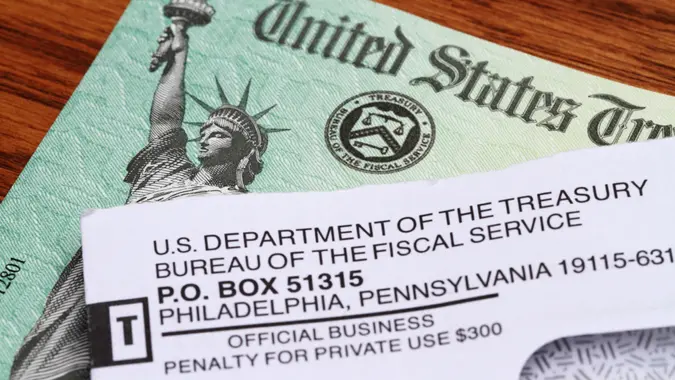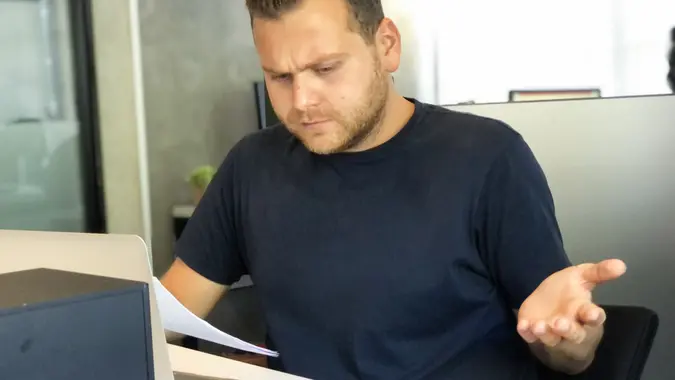I’m in My Late 30s and Wish I Had Taken These 3 Financial Steps Sooner

Commitment to Our Readers
GOBankingRates' editorial team is committed to bringing you unbiased reviews and information. We use data-driven methodologies to evaluate financial products and services - our reviews and ratings are not influenced by advertisers. You can read more about our editorial guidelines and our products and services review methodology.

20 Years
Helping You Live Richer

Reviewed
by Experts

Trusted by
Millions of Readers
Everyone makes mistakes, and hindsight is 20/20, but being in my late 30s, I have a few regrets when it comes to my finances. While I can’t go back in time and convince myself to make some changes to how I handle my money, I may be able to help those looking for advice. Read on to learn about the steps I should have taken sooner to avoid financial mishaps.
Maxed Out Retirement Funds
When I was young and just entering the workforce, retirement felt like an eternity away. While it’s still a ways off, I look back and think about how much better prepared I would be now if I’d maxed out my funds sooner.
I opened a Roth IRA when I was in my early 20s, but I only contributed to it when I remembered I had one. Roth IRAs are retirement funds you can contribute to with already-taxed money. This money can then grow within the account tax-free for years. When you withdraw your funds in retirement, you don’t have to pay any taxes.
The catch with a Roth IRA is that you can’t put as much money in as you may want. The government limits your contributions to $7,000 per year if you’re under 50 years old and $8,000 if you’re 50 or older. I think back at how much tax-free savings I missed out on because I didn’t max out my annual contributions.
I also wish I had maxed out my 401(k) retirement funds, or at least contributed as much as my employer would match. A 401(k) is another type of tax-advantaged retirement account, but it works a bit differently than a Roth IRA. With a 401(k), your contributions come straight from your paycheck before taxes. Then, when you withdraw money in retirement, it’s taxed as regular income.
One of the biggest advantages of a 401(k) is the employer match. Depending on your employer, when you contribute a certain monthly amount to your 401(k), they will match what you put in, effectively doubling it.
Ramit Sethi, author of the New York Times bestselling book “I Will Teach You to Be Rich,” says it best: “That is free money!”
Because my 401(k) was money I wouldn’t be able to touch for years, it didn’t seem as important at the time. Now I realize I missed out on a lot of retirement savings by not maxing out my employer matches.
Paid Off Debts Quickly
Like many students entering college, I didn’t put much thought into what having student loans actually meant. I figured I would graduate from college and get a high-paying job, and my loans would magically disappear over a year or two. This wasn’t the case, and once I began working and paying down my debts, I realized it would take me a very long time.
Because I wanted to spend my money on other things, I just paid the minimum balance each month. For years, I was primarily paying off the interest and making only a slight dent in the principal amount of the loan. On top of that, I took out a car loan and ran up a bit of a credit card balance, paying the minimum on that as well. Looking back, I would tell myself to use an effective strategy for paying my debts back faster.
A lot of personal finance experts, such as Dave Ramsey of “The Ramsey Show,” suggest using one of two methods to handle your debts. The snowball method involves listing all of your debts from largest to smallest. You pay the minimum monthly amounts on all of your debts but put extra money toward the smallest one. Once you pay off this debt, you put all that money toward the second smallest. This helps you gain momentum.
The second strategy is called the avalanche method. For this to work, you need to list your debts by interest and begin paying more toward the debt with the highest interest rate. In most cases, this will be your credit card balance. By paying off the debt with the highest interest first, you’ll have more money over time to tackle your other debts.
Paid Attention to Lifestyle Creep
George Kamel, a cohost of “The Ramsey Show,” breaks down lifestyle creep as “when your income goes up and your spending creeps right up to meet it.” Unfortunately, Kamel is speaking about most of my 20s. Whenever I received a raise, instead of being content with my current living situation, I saw it as an opportunity to upgrade my lifestyle and move into a bigger apartment, purchase the latest gaming system or spend more on nights out at more expensive establishments.
If I could go back, I’d tell myself to be disciplined and keep my spending at the same level. Then I could’ve afforded to put more money toward retirement or paid off debts faster and been in a much better financial position today.
More From GOBankingRates
 Written by
Written by  Edited by
Edited by 

























